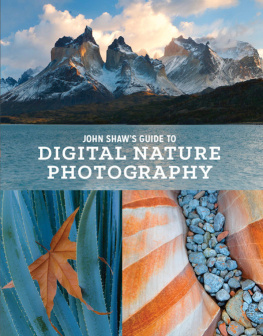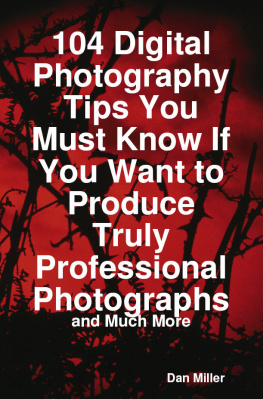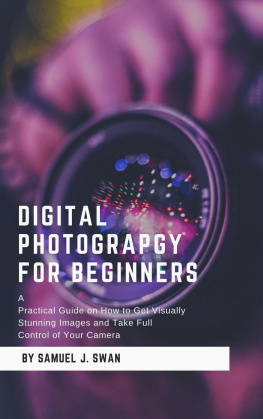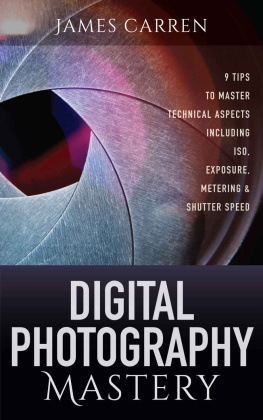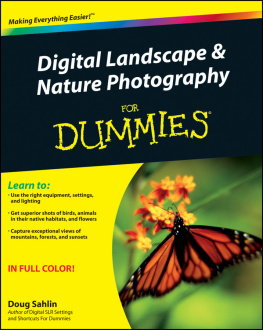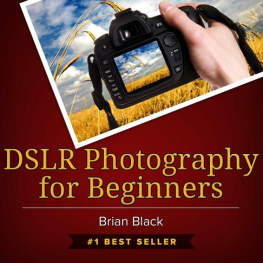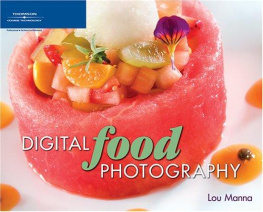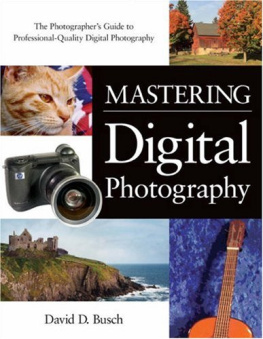Shaw J. - Guide to Digital Nature Photography
Here you can read online Shaw J. - Guide to Digital Nature Photography full text of the book (entire story) in english for free. Download pdf and epub, get meaning, cover and reviews about this ebook. genre: Art. Description of the work, (preface) as well as reviews are available. Best literature library LitArk.com created for fans of good reading and offers a wide selection of genres:
Romance novel
Science fiction
Adventure
Detective
Science
History
Home and family
Prose
Art
Politics
Computer
Non-fiction
Religion
Business
Children
Humor
Choose a favorite category and find really read worthwhile books. Enjoy immersion in the world of imagination, feel the emotions of the characters or learn something new for yourself, make an fascinating discovery.
Guide to Digital Nature Photography: summary, description and annotation
We offer to read an annotation, description, summary or preface (depends on what the author of the book "Guide to Digital Nature Photography" wrote himself). If you haven't found the necessary information about the book — write in the comments, we will try to find it.
, 250 .
Shaw J.: author's other books
Who wrote Guide to Digital Nature Photography? Find out the surname, the name of the author of the book and a list of all author's works by series.
Guide to Digital Nature Photography — read online for free the complete book (whole text) full work
Below is the text of the book, divided by pages. System saving the place of the last page read, allows you to conveniently read the book "Guide to Digital Nature Photography" online for free, without having to search again every time where you left off. Put a bookmark, and you can go to the page where you finished reading at any time.
Font size:
Interval:
Bookmark:


JOHN SHAWS GUIDE TO
DIGITAL NATURE
PHOTOGRAPHY


Copyright 2015 by John Shaw
All rights reserved.
Published in the United States by Amphoto Books, an imprint of the Crown Publishing Group, a division of Random House LLC, a Penguin Random House Company, New York.
www.crownpublishing.com
www.amphotobooks.com
AMPHOTO BOOKS and the Amphoto Books logo are registered trademarks of Random House, LLC.
is based on Chapter 6 in John Shaws Nature Photography Field Guide .
Library of Congress Cataloging-in-Publication Data
Shaw, John, 1944
John Shaws guide to digital nature photography / John Shaw.
pages cm
Includes index.
1. Nature photography. 2. PhotographyDigitaI techniques. I. Title. II.
Title: Guide to digital nature photognaphy.
TR721.S5155 2014
778.93dc23
2014009916
Trade Paperback ISBN: 978-0-77043-498-4
eBook ISBN: 978-0-7704-3499-1
Design by Margaux Keres
Composition by Happenstance Type-O-Rama
Captions for preliminary and chapter opener images:
: Lenticular cloud at sunset over the Alabama Hills, California. Nikon D3x, Nikon 24-70mm lens, 1 second, f /11, ISO 100
: Narrow-leaved cottonwoods in autumn, Montana. Nikon D800E, Nikon 24-70mm lens, 1/30 sec., f /14, ISO 100
: Sunset over the Salar de Uyuni salt flats, Bolivia. Nikon D800E, Nikon 24-120mm lens, 1/4 sec., f /16, ISO 200
: Autumn sugar maple, Michigan. Nikon D2x, Nikon 12-24mm lens, 1/10 sec., f /14, ISO 100
: Marble Cathedral, Lago General Carrera, Chile. Nikon D2x, Nikon 12-24mm lens, 1/30 sec., f /5, ISO 200
: Rocks and sandstone layers, Valley of Fire State Park, Nevada. Nikon D3x, Nikon 24mm T/S lens, 0.6 sec., f /22, ISO 100
: Crepuscular rays frame a tree with vultures, Masai Mara, Kenya. Nikon D2x, Nikon 70-200mm lens, 1/640 sec., f /8, ISO 140
: Sea star and barnacled rock, Oregon. Nikon D2x, Nikon 28-70mm lens, 1/3 sec., f /16, ISO 100
: Contorted tree on the shore of Lake Kussharo, Kokkaido, Japan. Nikon D3x, Nikon 200-400mm lens, 1/750 sec., f /6.7, ISO 100
v3.1


The act of photography
is the capture
of optimal data.
The art of photography
is the capture
of optimal vision.




Autumn quaking aspens on a frosty morning, near June Lake, California. Nikon D2x, Nikon 2870mm lens, 1/2 sec., f /16, ISO 100
I am thrilled with the digital revolution. In 1984, more than thirty years ago, Amphoto Books published my first book, The Nature Photographers Complete Guide to Professional Field Techniques . At that time, Kodachrome was the film of choice. In 2001, John Shaws Nature Photography Field Guide came out. The big news then was the advent of autofocus, autoexposure, and TTL (through-the-lens) flash. Most nature photographers had switched from Kodak to Fuji films. Well, things photographic have continued to change. For most photographers today, Kodak and Fuji are just historic names. Digital capture and processing is the norm: witness the fact that most young photographers have never shot a roll of film or waited days for prints to come back from a lab. Cameras now have menu choices, and publishing most often means uploading an image to the Web.
For me, it has been an exciting journey. I am fascinated by the digital process and amazed at what it allows me to do. When I last shot with a film camera, my high speed film was ISO 200; my current camera goes to ISO 204,800. With my camera, I can wirelessly control multiple flash units, customize how buttons and dials work, and view a live image direct from the sensor. Instead of waiting for film to be processed, thanks to computers and software I can have a finished image shortly after pressing the shutter button.
The process of nature photography is always changing, always evolvingnew products and new techniques come along all the time. I encourage you to develop your own way of working, your own equipment choices, and, most of all, your own vision. The book you are now holding is not in any way intended as a final word on how to take pictures. Rather, it is a summation of my thoughts about camera equipment and a description of some of the methods I currently use. I hope you will consider this work a starting point for your own explorations with a camera.
As you read this book, you will notice that I frequently refer to Nikon equipment. I dont in any way mean to imply that you should buy only Nikon products, although Ive been pleased with the system. I have worked with Nikon equipment all of my professional career, and I have photographed my own equipment when needed for illustration; however, quality nature photos can be taken with any currently produced photographic system. Youll also notice that I often recommend certain equipment or suppliers; I am not sponsored by any manufacturers, nor do I get subsidies or kickbacks for my recommendations.
In all of my books, I have included a statement that I will repeat here. Its as true today as it was thirty years ago:
To be a better nature photographer, be a better naturalist. The more you know about nature, the more you will see to photograph. Develop a deeper compassion for the world around us, and live by an ethic of concern for the subject matter.
Each year, I travel the globe to take pictures, often leading photo tours or workshops. The people in these groups are specifically interested in photographing the natural world, yet its on these trips that I inevitably hear the question What is there to photograph?
Truly this is the wrong question to ask; it leads photographers to take pictures that are empty of emotional content. Without passionate involvement, our pictures are nothing more than records. The question we should be asking is What is there to discover? Only after we have let our minds and eyes deal intimately with the abundance of natural marvels around us should we attempt to photograph them.
Photography should be both a process of discovery and a procedure for recording that discovery. In the process of photography, we order the chaos around us by making decisions. We decide to emphasize one aspect of the worldwhat we have discoveredand ignore all others. We want to represent that subject in a way that conveys how it has emotionally involved us. To do this, we must make conscious decisions about what to include within the photographic frame and how to organize the content. At this point, the procedure of photography enters. Now we must make technical choices involving the mechanics of photography: lenses, light, and exposure.
Font size:
Interval:
Bookmark:
Similar books «Guide to Digital Nature Photography»
Look at similar books to Guide to Digital Nature Photography. We have selected literature similar in name and meaning in the hope of providing readers with more options to find new, interesting, not yet read works.
Discussion, reviews of the book Guide to Digital Nature Photography and just readers' own opinions. Leave your comments, write what you think about the work, its meaning or the main characters. Specify what exactly you liked and what you didn't like, and why you think so.

